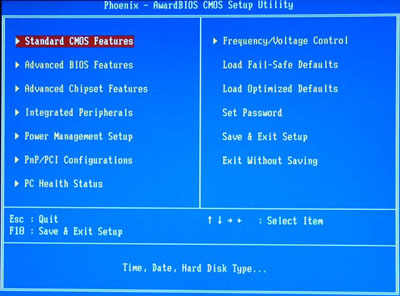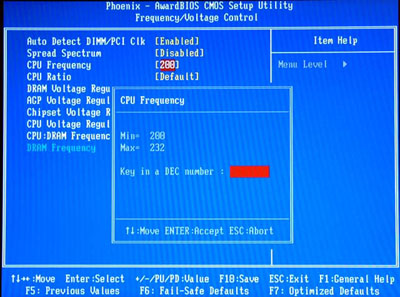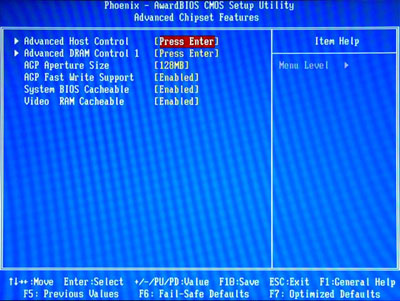DFI 748-AL: First Look at SiS 748
by Wesley Fink on August 30, 2003 12:00 AM EST- Posted in
- Motherboards
DFI 748-AL: BIOS and Overclocking
DFI uses the familiar Award BIOS for the 748-AL. The BIOS is the first “Performance” BIOS that we have seen used on a SiS 748 board, and the overclocking options are very complete for a board designed to sell for a low price.
The Main BIOS Screen layout includes the standard options plus selections for Frequency/Voltage Control, Advanced Chipset Features for system timings, and PC Health Status.

CPU FSB and multiplier ratios are adjusted in the Frequency/Voltage Control menu. Voltage adjustments are included for Core Voltage, Memory, AGP, and chipset voltage. This is a very complete set of controls for overclocking.

CPU only extends to 232FSB. This is probably adequate for a board without AGP/PCI lock, but we would have been happier to see a range to 250. Since SiS has implemented a “Fixed PCI/AGP” setting on other chipsets, we hope it is also possible on the 748 with a BIOS update.

SiS is famous for the incredible array of memory options they have provided in chipsets like the 645/655 series, so we hoped we would be seeing a full range of memory ratios. The only choices are SPD, 1:1 (DDR400), and 6:5 (DDR333). We hope to see more choices in the shipping BIOS.
System and Memory Timings are adjusted in the Advanced Chipset Features menu.

Memory adjustments are in submenu, called “Advanced Dram Control 1”. The Evaluation ROM has a very limited selection of settings. The only adjustments are “Normal” and “Performance”, and CAS values can only be selected if Performance is enabled. We suspect there will be additional memory timings available on the release DFI 748-AL.

CAS 2 would not work with our Corsair 3200LL, which is SPD-timed at 2-2-3-6. Normal appears to set timings of 2.5-4-4-8 at SPD with the Corsair. Performance and CAS 2.5 set 2.5-4-4-5. Even with these very conservative timings, the DFI performed extremely well, but if the release BIOS improves the memory timings, we sill see a whole new level of performance.

PC Health functions are included for monitoring functions, such as System and CPU temperatures, fan speed monitoring for 2 on-board fan connections, vCore, and Power Supply readings for all rails. DFI also offers options for setting shut-down temperatures for automatic system shut-down if a CPU overheats.
BIOS options for the 748-AL would be excellent on any board, but they are even more surprising on a SiS 748 board. We hope DFI will revamp the options for memory timings in the release BIOS, which are the only weak section of an otherwise strong BIOS. Options to 250FSB and PCI/AGP fix would also be welcome additions.
FSB Overclocking Results
In the past, when reviewing AMD motherboards, the only test method used at AnandTech was to remain at default multiplier while increasing the FSB until the highest stable FSB was reached. This method does report useful information for comparison, but there is another method for overclocking many recent Athlon motherboards. Most recent Athlon XP/Barton CPUs are unlocked or they behave as unlocked on recent motherboards. This allows overclocking by changing the multiplier or ratio of the Athlon CPU. On recent motherboards and Athlon CPUs, this requires no special “modification” to the board or CPU — it is now a standard feature available to any end-user who wants to use it. We have seen cases, like the DFI 748-AL that we are testing, where the FSB overclock is average or poor due to the lack of a PCI/AGP lock; when in fact, very high overclocks were possible by adjusting just the multiplier or both the multiplier and FSB.Since the multiplier or ratio adjustment is now a standard feature on many nForce2, KT600, and SiS 748 motherboards, we are adding a second overclocking test to Athlon reviews. We will also change multipliers and/or voltage on a reported air-cooling setup to find the highest stable overclock we can find using multiplier, voltage, and FSB with our standard components. We are not just looking for the highest number we could achieve. We will be trying to find a stable combination to provide an overclock that can still handle our stress testing. Both standard multiplier/highest FSB at default voltage and highest stable overclock will be reported.
The following setup was used on the DFI 748-AL for FSB overclocking:
| Front Side Bus Overclocking Testbed | ||||
| Default Voltage | Maximum Overclock | |||
| Processor: | Athlon XP 2500+ (Barton Core) |
Athlon XP 2500+ (1837MHz) (Barton Core – 11x166) |
||
| CPU Voltage: | 1.65V (default) | 1.775V | ||
| Cooling: | Thermalright SK-7 with 80mm Thermaltake Fan | Thermalright SK-7 with 80mm Thermaltake Fan | ||
| Power Supply: | Powmax 350W | Powmax 350W | ||
| Maximum OC: | 2332MHz (+27.3%) (11x212FSB) |
2450MHz (+33.4%) (12x204) |
||
Without a Fixed PCI/AGP bus speed, we expected the 748-AL would be limited in overclocking ability. The maximum stable overclock we could achieve at default voltage and multiplier was 212FSB. This is about the same as achieved on the better VIA KT600 boards, so we suspect that we may be seeing the AGP speed limit of the Radeon 9800 PRO video card more than the actual limit of the board. Fortunately, the DFI offers a full range of multipliers from 5X to 21X, and they work very well. We were able to set the FSB speed to a fixed 200 with the Dip switches on the board, increase the multiplier to 12.0 from 11.0 and mildly overclock the bus to 204 to achieve 2.45Gz with our Barton specified to run at 1.833GHz. This 33%+ overclock is close to the best we have achieved with this chip.
The nForce2 chipset, with PCI/AGP lock and a full range of multipliers, allows more possibilities with higher FSB options, but the DFI does allow the chip to reach its maximum speed with increased multipliers near one of the fixed FSB settings, like 200 and 166. What you can’t get without an AGP/PCI lock, are working settings like 10x240. The video card or PCI peripherals will likely give up before you can reach this setting.
The performance achieved from a board that will sell at a bargain price was excellent. The DFI is the only SiS 748 board with multiplier adjustments, and it does make a large difference in performance. We would be happier to see both a PCI/AGP frequency lock, and multipliers, but we were able to achieve excellent performance increases with the multiplier and FSB adjustments.










22 Comments
View All Comments
JAGedlion - Saturday, August 30, 2003 - link
... The DFI 748-AL has 5 IDE ... I see you are referring to PCI slots, can they be called IDE slots too?Anonymous User - Saturday, August 30, 2003 - link
wonder how far would the FSB go if the vdd was pushed into its max. i guess it would definetly go beyond 212MHz, maybe you should have decreased the multiplier.In fact, today I ran a few benchmarks with my epox 8k5a2 KT333 and reached as far as 215. pushing it further the AGP bus became bottleneck and i was using ATI's oldskool's rage128. it amazes me how come brand new hardware can't handle even 72MHz agp clock, whereas my 4 years old card handles 86MHz. in FSB200 (agp/pci 80/40) i'm not experiencing any staiblity issues burning it with prime or cpuburnK7 even 3days. odd
Anonymous User - Saturday, August 30, 2003 - link
One can easily see from his comment that Jeff7181 doesn't know much about these things, but still thinks he's got an argument. Anandtech crew are admirably wasting their efforts in trying to reason with such people.About the board. Two phase and no 12V connector drives me away from it just by looking at it.
About SiS. They have nice chipsets, but the motherboard makers skimp on the design because they use the SiS chipsets for another market than they do for instance with their nForce2 boards. That's unfortunate since I would rather go with SiS drivers than nVidias. Performance is often overemphasised when reliability and ease of use becomes a second thought for many buyers.
Anonymous User - Saturday, August 30, 2003 - link
May i make a helpful suggestion/request for the next (or even current) review? Could you please post the ranges of the bois setting instead of just the maximums? for example, instead of saying "cpu voltage in the full range, up to 1.85v" could you specify exactly what that range is? like 1.1-1.85v? I know the nForce boards can do this, but I'm unclear about 748 boards.I'm personally looking at this board for a home theater PC that I'm going to try and underclock the CPU and see if i can get it to run without a fan and still be fast enough to play DVD's... because of this, I'd like to know the minimum voltage you can run the CPU at, and I don't find that in a lot of reviews. Just that little change would satisfy the speed freaks as well as us quiet freaks.
just a suggestion...
Evan Lieb - Saturday, August 30, 2003 - link
Jeff,As Wesley mentioned and as I said before, Epox and ASUS' nForce2 Ultra 400 motherboards perform nearly exactly the same as the Gigabyte and DFI nForce2 Ultra 400 motherboards (and others) we use in AMD motherboard reviews. I have both boards in my labs and have decided not to send them to Wesley for retesting because I wouldn't want to waste his time with something like that.
Again, we have tested ASUS and Epox boards before and found them to perform within about 1% of other nForce Ultra 400 motherboards. We changed our testbed and made sure a few good nForce2 Ultra 400 motherboards we added for comparison to non-NVIDIA chipsets.
We may add those very popular Epox and ASUS boards to an nForce2 roundup of some type. But for a SiS 748 review like this one, the boards we used were perfectly adequate.
Dennis Travis - Saturday, August 30, 2003 - link
Very good review Wes, keep up the great work.Wesley Fink - Saturday, August 30, 2003 - link
Jeff7181 -I'm asking, Jeff, that you Please give me a break. I took over AMD about 6 weeks ago, and all Athlon reviews prior to that were done by Evan. Evan has answered here, on every post you have made on every AMD review, that the performance difference for Ultra 400 versions was very small, which is why he chose NOT to review the Ultra 400 updates of the boards you mention. The results of our tests of the regular nForce2 versions of the boards you mention are in our database. We also have the two top Ultra 400 performers - the DFI NFII Ultra LANParty and Gigabyte 7NNXP with UPDATED benchmarks in our tests for your comparison. If you recall, we also changed our video cards and benchmark suite recently, and we are finally accumulating a useful database of new benchmark data.
My point, Jeff, is I do NOT have access to the motherboards you mention and cannot add them to our database. I am doing my best to provide useful information to AMD fans, but I cannot provide what you ask. My next AMD review is a Ahtlon64 Preview, and with the launch only 3 weeks away it just doesn't make good use of review time to request an Asus A7N8X Deluxe and retest it.
If you can please show a little patience we will do our best to provide the kind of information you are looking for in the future.
Thank you.
Wesley Fink - Saturday, August 30, 2003 - link
Charts are in Flash because it uses less bandwidth than any of the alternatives. With over 3300 articles and reviews on-line plus News and Forums, bandwidth is a very important subject to a site like AnandTech.Anonymous User - Saturday, August 30, 2003 - link
Why are the charts in Flash? A simple jpg or gif would do.Jeff7181 - Saturday, August 30, 2003 - link
Again I ask, where the hell is the comparisons to the motherboards we all know? The A7N8X Deluxe, NF-7, 8RDA+. And what's with the cheesy title? Can SIS outperform nVidia's nForce2? I could have answered that without even testing them! Geeze... what's going on at AnandTech? These reviews suck!